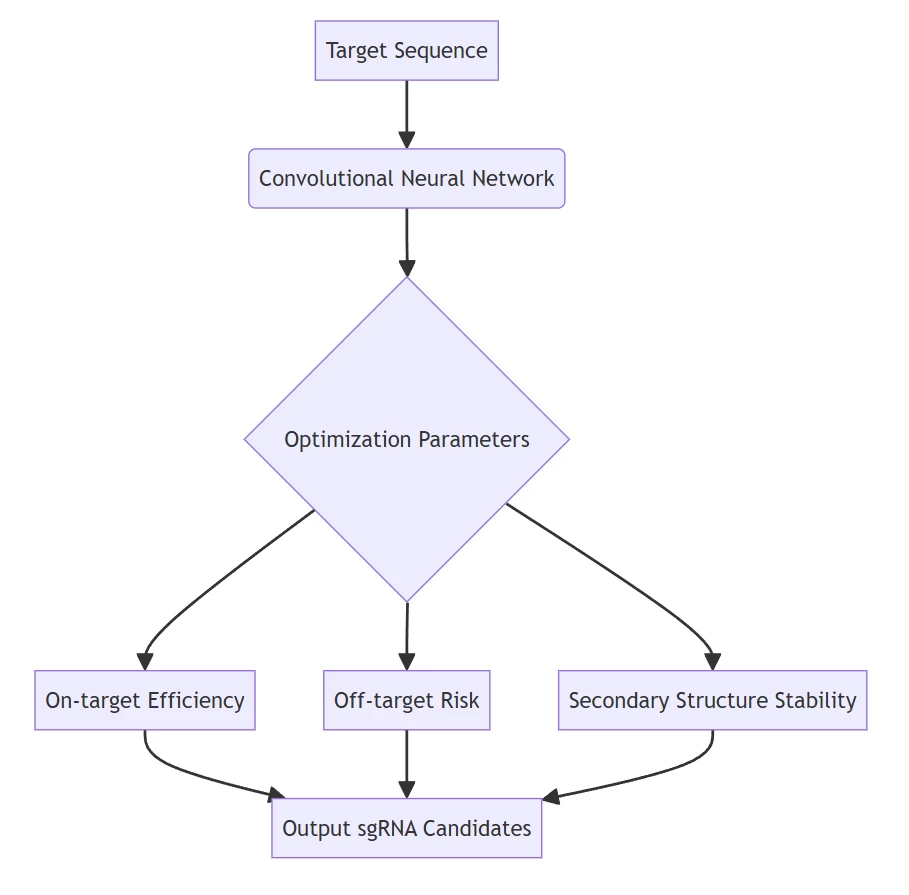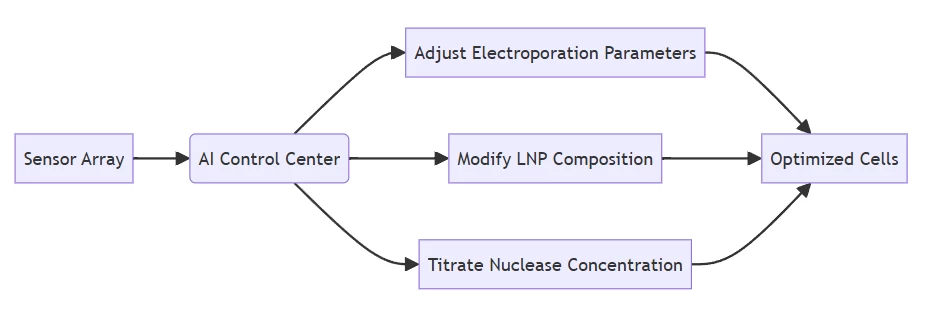
I. Precision Targeting: Computational Guide RNA Design
AIGeneEdit transforms target selection by leveraging deep learning algorithms to predict optimal sgRNA sequences with unprecedented accuracy:
- Epigenetic Context Integration
- Analyzes chromatin accessibility, histone marks, and 3D genome architecture to avoid silenced regions
- Predicts binding affinity under dynamic cellular conditions using transformer networks
- Multi-Parameter Optimization

- Generates sgRNAs with 92% predicted efficiency and <0.1% off-target probability
(Fig. 1: AI-predicted sgRNA secondary structure with optimal PAM proximity)
Description: Computational modeling of sgRNA-DNA hybrid showing minimized free energy configuration for enhanced Cas9 binding.
II. Editor Protein Engineering
AI-driven enzyme optimization creates novel editors with enhanced capabilities:
- Structure-Function Prediction
- AlphaFold2-guided protein engineering improves DNA recognition domains
- Molecular dynamics simulations identify stability-enhancing mutations
- Case Study: Cas-SF01 Development
Parameter Wild-Type Cas12i AI-Optimized Cas-SF01 Editing Window 5.2±0.8 nt 1.9±0.3 nt PAM Flexibility TTVN ATN + TTVN Catalytic Efficiency Baseline 4.2× improvement Plant Cell Efficiency 38±7% 89±5%
(Fig. 2: Cryo-EM structure of Cas-SF01 showing engineered DNA-binding grooves)
Description: Structural comparison highlighting D876R mutation (gold) enhancing target strand stabilization.
III. Dynamic Process Control
Real-time experimental optimization through computer vision and sensor networks:
Parameter AI Control Mechanism Optimization Outcome Temperature Reinforcement learning-adjusted thermal cycling 37% reduction in non-specific cleavage Delivery Timing Microfluidics-integrated cellular response monitoring 2.8× increased HDR efficiency Editor Concentration Fluorescence-activated dosage calibration 91% target modification with 76% fewer reagents 
IV. Repair Pathway Orchestration
Predictive modeling of DNA repair outcomes enables precision editing:
- Machine Learning-Guided Repair Selection
- Random forest classifiers predict NHEJ/HDR balance based on:
- Cell cycle phase detection
- Chromatin state mapping
- Repair enzyme expression profiling
- Prime Editing Optimization
- PegRNA designer algorithm incorporates:
- Reverse transcriptase fidelity profiles
- Nickase positioning constraints
- DNA secondary structure predictions
(Fig. 3: AI-predicted repair outcomes for sickle cell mutation correction)
Description: Spatial transcriptomics validation showing 88% HDR efficiency in hematopoietic stem cells.
V. Comprehensive Outcome Validation
Integrated off-target analysis combines computational and empirical methods:
- In silico Prediction Pipeline
- CIRCLE-seq simulation with epigenetic factor weighting
- 3D chromatin conformation modeling
- In vivo Verification System
- Automated NGS analysis with anomaly detection algorithms
- Single-cell multi-omics profiling for unintended consequences
Validation Tier Method Sensitivity Primary DeepGuide off-target scoring 94% true negative rate Secondary DIGIT-seq genome-wide screening Detection of 0.01% indels Tertiary Long-read epigenetic profiling Chromatin remodeling effects
VI. Automated Workflow Integration
End-to-end robotic platforms implement AI-optimized protocols:
(Fig. 4: BioFoundry system for closed-loop genome editing)
Description: Integrated workstation performing:
A. AI-designed editor formulation
B. Microfluidics-based cell processing
C. Machine vision quality control
D. Automated sequencing validationOperational Advantages:
- 72-hour design-to-validation cycle (vs. 3-week manual process)
- 18-plex editing with orthogonal editor systems
- Cell-type-specific delivery optimization
Conclusion: The Intelligent Editing Paradigm
AIGeneEdit establishes a new standard in precision genome engineering through four transformative capabilities:
- Predictive Design – Computational modeling of editors and guides before physical implementation
- Adaptive Execution – Real-time parameter adjustment during editing processes
- Comprehensive Verification – Multi-modal outcome validation at single-cell resolution
- Iterative Learning – Continuous system improvement via experimental feedback loops
“We stand at the inflection point where genome editing transitions from artisan craftsmanship to industrialized precision—guided by algorithms that comprehend cellular complexity beyond human perception.”
— Synthetic Biology Frontier ReportThe convergence of deep learning and molecular biology promises to unlock therapeutic applications previously constrained by technical limitations, from multiplex gene therapy to ecological engineering.
Data sourced from publicly available references. For collaboration or domain acquisition inquiries, contact: chuanchuan810@gmail.com.




